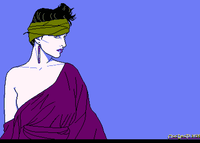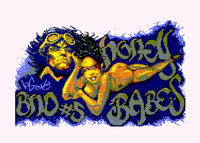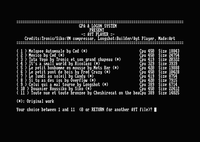Amstrad CPC

The Amstrad CPC 464 was one of the most successful computers in Europe. More than two million computers were sold. Despite its ordinary characteristics (like those of the Sinclair Spectrum and often less interesting than those of the others like the Commodore 64 or Atari XL/Xe series) or odd features (like video memory or strange floppy disk format), it was very popular because of its really low price and its interesting commercial concept : all peripherals were sold together (like the Commodore PET that was sold years earlier): CPU/keyboard, tape recorder, monitor (monochrome green or colour).
A huge number of programs and peripherals were developed for this machine. It ran AmsDos (Amstrad's Operating System). AmsDos was completely embedded in the Basic using so-called RSX commands starting with |, but it could not format disks, you needed a special application for that.
The 464 also could use CP/M 2.2 or 3.0 when used with an external Floppy disk unit (3" Hitachi, 180 KB / face). A lot of great CP/M software was adapted for the Amstrad CPC.
About 42 KB RAM was available for the user, the video memory and the ROM were mapped on the same addresses with a dedicated chip to switch the memory banks automatically.
Notice that the first Amstrad CPC prototype (called "Arnold", which gave the name ROLAND (Arnold acronym) to several CPC games) was built around a 6502 processor and then changed to a Z80 late in the computer’s development. A few months later, the CPC series would be completed with a computer which offered a built-in floppy disk unit: the CPC 664.
(Note: Description used with courtesy of http://www.old-computers.com)
The Amstrad CPC 664 was sold for only one year. Successor to the Amstrad CPC 464, it was quickly replaced by the Amstrad CPC 6128. It was sold with a monochrome green or colour monitor and a built-in floppy disk drive. The floppy disk format was the Hitachi 3 inch, an uncommon format already used on the Tatung Einstein and the Oric Atmos. Like the CPC 464, its price was very low, which explains why about 10,000 units were sold in less than a year.
The Locomotive Basic interpreter was the same as the CPC-464, but had some extra commands like FILL to fill a graphics area, FRAME to produce smoother graphics, and MASK to draw a series of dots. The editor was also slightly improved.
The 664 was delivered with the AMSDOS and CP/M 2.2 operating systems. The LOGO language was supplied with the CP/M disc.
(Note: Description used with courtesy of http://www.old-computers.com)
The Amstrad CPC 6128 was the successor to the Amstrad CPC 664 which had a very short life. It had almost all the same features as the 664, except the memory. Like the 664, only 42 Kb could be accessed, the upper 64 Kb were used as a RAM disk or to store data. It was sold with quite a good quality monitor (monochrome green or color) and a built-in 3" floppy disk drive (2 x 180 KB).
It ran under Amsdos (the Amstrad Operating System) or under CP/M 2.2 or CP/M 3.0 (CP/M +). The CP/M 2.2 OS was bundled with DR Logo and CP/M+ with GSX (the graphic extension of CP/M). Like the CPC 664, the Amstrad CPC 6128 was almost fully compatible with the CPC 464.
The German version of the Amstrad (Schneider CPC 6128) had different "real" connectors instead of mainboard edge connectors. Norbert Unterberg reports that the main reason for this was that the original Amstrad did not pass the German "FCC" test because it was polluting its surroundings with electromagnetic waves, and the rules for that were much stricter in Germany. That's why the Schneider got real connectors and a metal housing inside.
However, after "Schneider Rundfunkwerke" stopped selling the Amstrad CPC series of home computers and the PCW series of word-processors, Amstrad continued to sell the CPC under the Amstrad brand name in Germany.
The ROM was identical for all brands of Amstrad: Schneider, Orion, Awa,...
Note that there is a way to find out all the brand names under which Amstrad distributed their CPC range. Go check this page to get them all. Easy to do and funny to see!
Lots of Amstrad or third-party peripherals could be added, among them:
• 2nd 3"/3.5"/5.25" FD max 800k
• 20MB Hard disk, 4x5MB
• Max 252x16k EPROMS
• Max RAM Installed 640k (576k in use)
• RS-232 Interface, Modem
• 3 key Mouse, Light Pen
• Centronics Dot Matrix Printer
• "PC-Hormon" MSDOS emulator...
(Note: Description used with courtesy of http://www.old-computers.com)
Thanks to pulkomandy for the image!
Emulators that exist for this platform include;
Recent releases:

|
pelrun | Nov 2025 | |

|
cpcitor | Nov 2025 | |

|
Beb | Nov 2025 | |

|
Vanity | Nov 2025 | |

|
MacDeath | Nov 2025 | |

|
MacDeath | Nov 2025 | |

|
Logone | Nov 2025 | |
|
|
Doclands | Nov 2025 | |

|
CeD | Nov 2025 | |

|
Cocoon and Condense and Overlanders | Nov 2025 | |

|
Bug Powell | Nov 2025 | |

|
Bug Powell | Nov 2025 | |

|
Overflow | Nov 2025 | |
|
|
Okeanos | Nov 2025 | |

|
Benediction and Da Boxon Team | Nov 2025 | |

|
CeD | Nov 2025 | |
|
|
m_dr_m | Nov 2025 | |

|
Optimus | Nov 2025 | |
|
|
Targhan | Nov 2025 | |

|
GPA and Logon System | Nov 2025 | |

|
GPA and Logon System | Oct 2025 | |

|
CrackY | Oct 2025 | |

|
Benediction | Aug 2025 | |

|
Vanity | Aug 2025 | |

|
Logiker / Vintage Computing Carinthia | Jul 2025 | |
|
|
Warlord / phObos Team | Jul 2025 | |

|
cpcitor | Jul 2025 | |

|
Contrast and Vanity | Jun 2025 | |

|
MacDeath | Jun 2025 | |

|
Tristar and Red Sector Inc. | Apr 2025 |